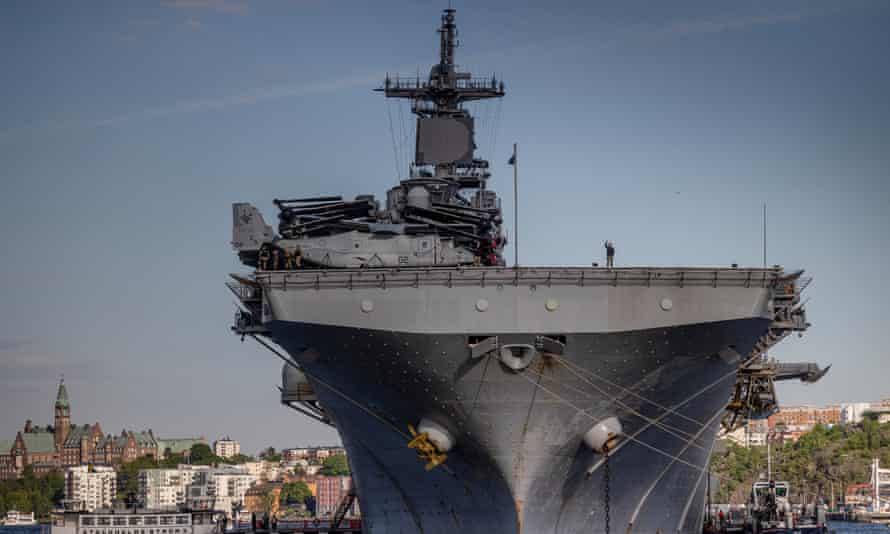Ukrainian president Volodymyr Zelenskiy has visited the frontline close to the fiercest fighting between his country’s troops and Russian forces in the east, as the UK and Spain said they would defy threats from the Kremlin by sending missile systems to help Kyiv.
Wearing his trademark khaki T-shirt and trousers, Zelenskiy visited the beleaguered city of Lysychansk on Sunday, just a few kilometres south from Sievierodonetsk, where Ukraine claims to be fighting back in one of the war’s biggest ground battles.
The fight to push Russian forces back received a boost on Sunday when the UK government said it would supply long-range rocket artillery to Ukraine, despite a threat on Sunday from Russia’s president, Vladimir Putin, to bomb fresh targets if similar weapons from the US were delivered to Kyiv.
Zelenskiy also visited the Donbas city of Soledar in a rare outing by the Ukrainian president outside the capital Kyiv since the start of the Russian invasion on 24 February that could be his closest yet to the frontline.
“I went with the head of [my] office to the east. We were in Lysychansk and Soledar,” Zelenskiy said in his nightly video address, adding he would not elaborate on the visit.
In two separate videos released later, Zelenskiy was shown talking to troops in confined, bunker-like structures, presenting some with awards and addressing others.
“What you all deserve is victory – that is the most important thing. But not at any cost,” Zelenskiy said in one of the videos.
Lysychansk and Sievierodonetsk are in the Luhansk region and Soledar is in the Donetsk region. Both regions make up the broader Donbas region, Ukraine’s industrial heartland, which Russia claims is on a mission to “liberate”.
Earlier on Sunday, Zelenskiy said he had also visited frontline troops in the south-eastern region of Zaporizhzhia, whose governor claims that 60% of the region is under Russian occupation.
The UK will send a handful of tracked M270 multiple launch rocket systems, which can hit targets up to 50 miles (80km) away, in the hope they can disrupt the concentrated Russian artillery that has been pounding cities in eastern Ukraine.
Spain is also stepping up its support for Ukraine, according to government sources cited by newspaper El País. Spain is to supply Ukraine with anti-aircraft missiles and Leopard battle tanks along with training for the equipment. Spain had previously sent only ammunition, individual protection equipment and light weapons to Ukraine.
The additional military support for Ukraine came after Nato began almost two weeks of naval exercises led by the US in the Baltic Sea on Sunday.
More than 7,000 sailors, airmen and marines from 16 nations will take part, including two aspiring to join the military alliance, Finland and Sweden, in the annual Baltops (Baltic operations) exercise that has been running since 1972.
Nato said that with both Sweden and Finland participating, it was “seizing the chance in an unpredictable world to enhance its joint force resilience and strength”.

Finland and Sweden both have a long history of military non-alignment before their governments decided to apply to join Nato in May, a direct result of Russia’s invasion of Ukraine. Over the past years, Moscow has repeatedly warned Helsinki and Stockholm against joining the western military alliance and warned of retaliatory measures if they did.
“It is important for us, the United States, and the other Nato countries to show solidarity with both Finland and Sweden in this exercise,” US General Mark Milley, chairman of the joint chiefs of staff, said on Saturday during a news conference aboard the large amphibious warship USS Kearsarge, which was moored in central Stockholm.
Milley, speaking to the Swedish prime minister Magdalena Andersson, stressed that the Baltic was a strategically important body of water and “one of the great seaways of the world”.
He said from Moscow’s perspective, Finland and Sweden joining Nato will be “very problematic” and leave Russia in a difficult military position as the Baltic’s coastline would be almost completely encircled by Nato members, except for Russia’s Baltic exclave of Kaliningrad and the Russian city of St Petersburg and its surrounding areas.
As Nato’s close partners, Finland and Sweden have participated in the naval drill since the mid-1990s. This year’s Baltops exercise is scheduled to end in the German port of Kiel on 17 June.